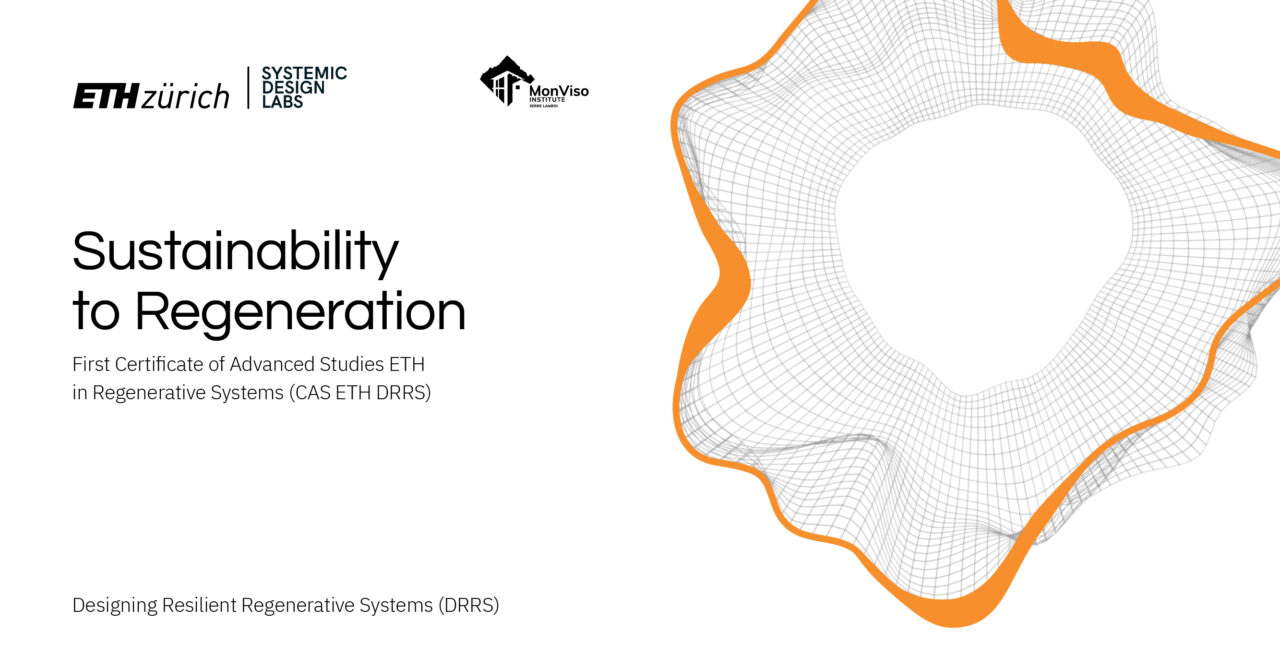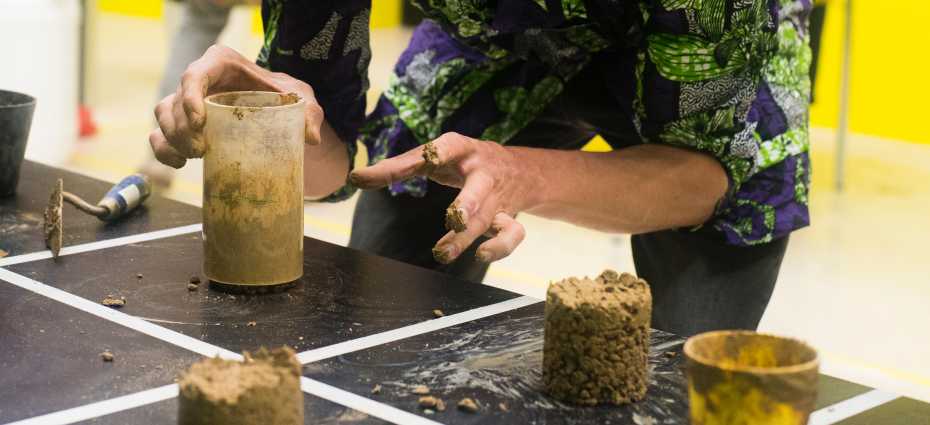Department / Institute: Department of Civil, Environmental and Geomatic Engineering (D-BAUG)
Mehr Wohnraum, aber für wen?
6. Juni 2023, 17.30 | Karl der Grosse, Kirchgasse 14, 8001 Zürich. Bauen ist das Gebot der Stunde, um dem aktuellen Wohnungsmangel zu begegnen und Verdichtung zu fördern. Neueste Studien über den Kanton Zürich zeigen jedoch, dass der aktuelle Wohnungsbau vulnerable Menschen verdrängt.
Sustainable Future Mobility Symposium: CSFM’23

Crises hold chances. We are finding ourselves in times of deep, nested, and accelerating ecological, social, cultural, political, economic, and personal crises. This dynamic situation is highly complex and uncertain, unpredictable, and even chaotic. Yet within chaos is creativity, and creativity leads to chances for renewal.

earth. bio-based. reused.
Think regenerative!
It is time to go beyond sustainability. Alternative solutions out of local resources such as earth, bio-based, and reused materials are emerging all over the world and are triggering regenerative output, thanks to their capacity to contribute to the restoration and improvement of the surrounding natural and social environment. However, they are not widespread in the construction sector due to a lack of information on the side of decision-makers and a lack of competence on the side of practitioners.
The MAS/CAS ETH in Regenerative Materials, international ETH training programmes launched by the Chair of Sustainable Construction of the ETH Zurich, aim to tackle this problem. These teachings offer knowledge and skills to question our conventional construction techniques and to promote regenerative materials from resource extraction to construction site, operation, and end-of-life of the building materials, starting from the preliminary phase of the construction programme.
Website CAS ETH in Regenerative Materials
CAS ETH Regenerative Materials
Sustainable Construction | Hygrothermal Specialisation starts in September 2023, application until 31 July 2023. It is time to go beyond sustainability. Alternative solutions out of local resources such as earth, bio-based, and reused materials are emerging all over the world and are triggering regenerative output.
disP 58/4, December 2022
E-Bike – Chancen und Risiken des Verkehrsmittels der Zukunft
Stadtwerdung im Zeitraffer
SPUR Research Colloquium
FCL Global Seminar: Vehicle-to-Grid for Car-sharing: Can Shared EVs Support the Power Grid in Future Cities?
How Spatial Policies can Leverage Energy Transitions − Finding Pareto-optimal Solutions for Wind Turbine Locations with Evolutionary Multi-objective Optimization
What drives deforestation in Switzerland?
Neubauten verdrängen vulnerable Personen | New housing developments displace vulnerable persons
Wo sollen Windräder in der Schweiz stehen?
Eine Studie von ETH-Forschenden zeigt erstmals, wie sich die Lockerung der Raumplanung auf den Ausbau der Windenergie in der Schweiz auswirken würde. Will man möglichst wenig Windanlagen in den Alpen und in der Schweiz generell, sollte man die Nutzung von windstarken Agrarflächen im westlichen Mittelland erwägen. Artikel in More
MAS ETH in Raumentwicklung
CAS ETH in Raumentwicklung und Planungspraxis
ETH RAUM | Bewerbung bis 30. Juni 2023 (2. Runde). Das CAS in Raumentwicklung und Planungspraxis behandelt die aktuellen und zukünftigen Herausforderungen der Raumentwicklung sowie zielführende Methoden und Verfahren für eine innovative Planungspraxis. Der Studiengang ist als Denklabor für raumrelevantes Handeln und Entscheiden konzipiert.
Erkenntnisse zum aktuellen Wohnungsnotstand: Bautätigkeit, Verdrängung und Akzeptanz
Neuste Auswertungen zeigen, dass neue Wohnungen hauptsächlich durch Ersatzneubauten geschaffen werden, zu direkten Verdrängungen von vulnerablen Personengruppen führen und bauliche Verdichtung eher akzeptiert wird, wenn es ökologische und soziale Begleitmassnahmen gibt.
Mountain Resilience: A Systematic Literature Review and Paths to the Future
Mountains are home to a considerable share of the human population. Around a billion people live in mountainous areas, which harbor rich natural and sociocultural diversity. Today, many people living in mountainous areas worldwide face fundamental changes to their cultural and economic living conditions. At the same time, More
Reviewing the Resilience Concept for Designing more Adaptive and Innovative Systems
A recently published review paper on mountain resilience identifies origins of the resilience concept with earliest roots in material, infrastructure, and physical resilience. Resilience today is seen beyond shock absorption towards transforming a system for making it stronger, as both more adaptive and more innovative. Several future engagement More
NSL Veranstaltungsplakat Frühjahrssemester 2023
Wachstum, Boden, Wohnen? Nachhaltige Verdichtung bedingt aktive kommunale Boden- und Wohnungspolitik
Wachstum, Boden, Wohnen? Schweizer Städte und Gemeinden sind seit 2014 gesetzlich dazu verpflichtet ihre «Siedlungsentwicklung nach innen» (Art. 1 RPG) zu lenken. Gleichzeitig werden ihre verfügbaren Bodenreserven knapp und die Wohnbevölkerung wächst stetig. Wie können kommunale Planer:innen aktiv und strategisch in den Wohnungsmarkt eingreifen, um so die Innenentwicklung More
Quo vadis Raumentwicklung Schweiz? Umfrage zur Zukunft der Raumentwicklung Schweiz
Die Raumentwicklung ist ein komplexes Themenfeld im stetigen Wandel und eine interdisziplinäre Diskussion über dessen Zukunft nötig. Um auf künftige Bedürfnisse der Planungspraxis einzugehen, wurde eine umfassende Befragung zu Forschungsthemen und Lehrinhalten durchgeführt. Die Resultate verdeutlichen den Wunsch nach einem allgemeinen «Mehr» an Lehre und einer stärkeren Ausrichtung More
Flood Risk Mitigation in Refugee Settlements
The intensity and frequency of natural hazards are on the rise. Refugee settlements face a particular risk from such disruptive events due to their precarious built environment and socio-economic situation. The SPUR and PLUS research groups at ETH Zürich, in collaboration with UNHCR and the Swiss Development Cooperation More
hEART 2023 – 11th Symposium of the European Association for Research in Transportation
MATSim User Meeting 2023
E-Bike City Kolloquium
8. Juni 2023, 9:00 – 18:30 | ETH Zürich, Zentrum, Audimax. An diesem Kolloquium werden die sieben Forschungsgruppen des D-BAUG Leuchtturmprojekts «E-Bike City» nicht nur ihre vorläufigen Ergebnisse präsentieren, sondern auch die Teilnehmenden aktiv in die Gestaltung der Forschungsfragen einbeziehen.
Transformation of Urban Landscapes
ETH RAUM – The New Platform for Spatial Development
ETH RAUM is the new ETH platform offering a broad range of courses in spatial development. The MAS and the three new CAS programmes focus on spatial development, planning practice, process design, and the city as a laboratory of the future. Spatial planning and development are undergoing a More
Schatzkammer Wald: Lebensraum, Inspirationsquelle, Ressource
Integrierte Abwicklungsmodelle aus Perspektive der Bauherrschaft
Verkehrsgerechtigkeit
Book Talk about «Migrants and Machine Politics. How India’s Urban Poor Seek Representation and Responsiveness»
disP 58/3, September 2022
ETH RAUM – Die neue Plattform der ETH zur Raumentwicklung geht online!
ETH RAUM ist die neue Plattform der ETH Zürich, mit einem breiten Angebot in der Raumentwicklung. In einem MAS und drei neuen CAS-Programmen stehen Raumentwicklung, Planungspraxis, Prozessdesign und die Stadt als Laboratorium der Zukunft im Zentrum. Das Bewerbungsfenster ist bis 30. April 2023 geöffnet. Die Programme starten im More
Actors, Arenas and Aims: A Conceptual Framework for Public Participation
This paper systematises knowledge of public participation by bringing together existing concepts and theories from planning literature to conceptualise the 3A3-framework of participation. The framework presents participation as an emergent phenomenon, shaped by the dimensions: actors, arenas and aims. Each of these dimensions consists of three interacting elements. More
Difference-Oriented Urban Planning (DiffUrb)
Cities are characterized by a pluralism of people and uses. This fact is becoming increasingly relevant for the practice of urban planning. Any handling of differences regarding living conditions and spatial and temporal uses is frequently based on an analysis that only considers a single feature such as More
Prof. Dr. Francesco Corman zum ausserordentlichen Professor für Transportsysteme befördert
Re-considering the Status Quo: Improving Calibration of Land Use Change Models Through Validation of Transition Potential Predictions
Difference in Urban Planning. Interdisciplinarity as an Approach to Understanding the Complexity of Contemporary Urban Societies
Cities attract people of diverse origins, religious practices, socioeconomic status, and everyday practices. As a result, urban planning is challenged to respond adequately to this demographic heterogeneity. These urbanization processes highlight the importance of placing difference at the centre of the urban planning agenda.
Planning Instruments Enhance the Acceptance of Urban Densification
Forecasting District-wide Pedestrian Volumes in Multi-level Networks in High-density Mixed-use Areas
Understanding Modal Splits Before, During, and After the Pandemic
The adjustments of mobility patterns during early stages of the pandemic are well understood. However, various effects are intertwined in these observations and therefore the findings’ robustness remains questionable. The MOBIS-Covid data set provides a unique opportunity to put these initial findings in perspective as a large panel More
disP 58/2, June 2022
“Yes, but not like this!” – Why densification often lacks public acceptance
Densification is a fundamental principle of urban planning and development today. Nevertheless, it often encounters local resistance. A group of ETH researchers has now systematically investigated factors influencing public acceptance of densification, focusing on the canton of Zurich and six cities of global importance. One key factor: affordable More
Size Matters
NSL Veranstaltungsplakat Herbstsemester 2022
Operationalising Place for Land System Science
Will E-Bikes Bring Amsterdam and Copenhagen to Switzerland?
Globescape: Understanding Place, Fostering Place-making
Unprecedented urbanisation is transforming productive agricultural land into standardised settlements in which people are losing their sense of place and the motivation to initiate change. How people feel about, interact with, or want different places to be shaped, has been systematically researched through the lenses of place and More